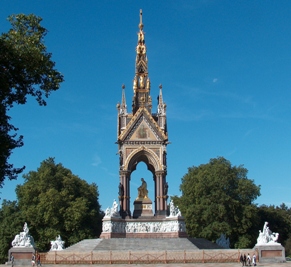
The Albert Memorial in Hyde Park is one of the great sculptural achievements of the Victorian era, and for sheer scale, opulence and number of individual statues and sculpted figures in unequalled. The composition centres on a large gilded statue of Albert seated in a vast Gothic shrine, and includes a frieze with 169 carved figures, larger than life sized groups representing four Continents and four Industries, eight bronze figures of the Sciences, and higher up the eight Virtues and highest of all, eight angels in two tiers. The canopy also includes heraldic lions, vast Salviati mosaic pictures, and innumerable smaller decorations. Some of the statues are so high as to be seen only at a steep angle, needing binoculars to appreciate properly. Looking up, if the sun is bright, it is hard to focus at all on one or another aspect of the monument. And to look at each individual figure on the frieze for just 30 seconds apiece would mean nearly an hour and a half to view them all. How, then, can we engage with this vast assemblage? One way to start is to look at it as a whole, from a distance, from any side or across the road from the Albert Hall. Then it looks like one giant jewel, or shrine. The architect, George Gilbert Scott, was indeed much inspired by miniature medieval shrines, and also by the medieval Eleanor Crosses, set up by King Edward I in memory of his dead Queen, Eleanor, wherever the funeral procession went. (Though the original cross in London did not survive, the current Charing Cross is closely based on the earlier design; see this page for the other surviving Eleanor crosses). More so than any other monument in England that I have seen, looking at the Albert Memorial from a distance, it has the feel then of something precious, given by the lavish use of colour and bright gold.
Europe, Africa, Asia and America.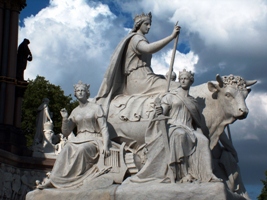
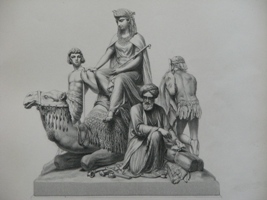
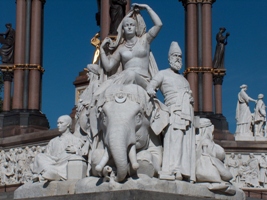
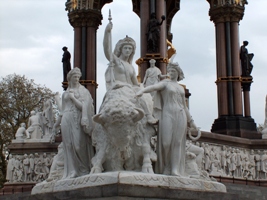
The outermost groups of the monument, which we can approach most closely and view from different sides, are the four Continents:
The sculptor in overall charge of designing the statuary of the memorial was H. H. Armstead, and there is a common conception and unity of design to the statuary, which in the case of the Continents means that each sculptural group is centred on a mounted figure, with four surrounding figures afoot or seated. We start with Europe, by Macdowell, the most civilised group, with a central queen mounted on a bull, surrounded by four more seated queens, each with their crown, somewhat reminiscent of the Charing Eleanor Cross noted above. A very British Europe, including a Britannia ruling the waves (for more allegorical statues of Britannia, see this page), all rather serene and composed. The Africa group, by William Theed, gives prominence to Egypt, represented by a woman with magnificent headdress on a seated camel and a servant boy with hand resting on a sphinx (if you like statues of sphinxes, see this page). On the other side, a seated Arab, and behind, a European woman gestures towards an almost naked African man. Asia, by Foley, has the central figure as a semidraped Indian girl, in a superb pose, on a seated elephant, flanked by a vaguely Chinese Oriental, an Assyrian, another turbaned Arabic figure, excellently Biblical, and an equally Biblical reclining figure, some spice merchant perhaps. (Notes on elephant sculpture are on this page.) Finally, a contrast with John Bell's sculptural group of America, the young continent, wbere the figures are more primitive, more urgent and active, with the central figure on a rampant bison pawing the earth and presenting its sharp horns to the viewer. The pyramidal compositions are designed to be seen from almost all sides, unlike the case for so many large sculptural groups, for example those in the Guildhall or Westminster Abbey, which are to be seen essentially from the front only. The Albert Memorial Continents repay many visits, each time presenting some new aspect and subtlety to the viewer.
Next to the four inner groups, the Industries:
Agriculture, Commerce, Engineering and Manufactures respectively. 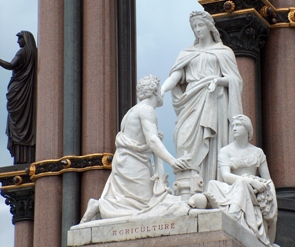
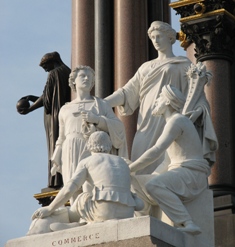
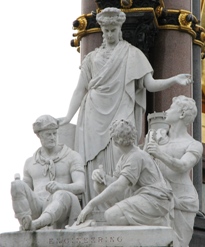
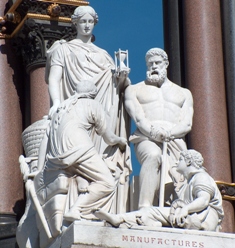
The Industries are further from the viewer, raised up higher, and a little smaller, each based on a central standing allegorical statue of a girl with three accompanying figures. They can still be seen from a variety of views from different sides, and the greater height gives opportunity for the more oblique views to give fine silhouettes against the sky. Calder Marshall's Agriculture is a somewhat sentimental Classical group of shepherd with sheep, muscular labourer with modern tools, and a seated girl with sheaf of corn, with the central figure making a benedictory gesture. In Thomas Thornycroft's Commerce, the central figure holds a rather modest cornucopia, and is closely surrounded by three merchants with their wares. Engineering, by John Lawlor, features a variety of mechanical devices, but while one figure of a miner has modern clothing and boots, the others are draped in classical garb. Manufacturing by Weekes is to my mind the best of the four groups, with a harmonious arrangement of the figures in a more noble classic vein, including a Herculaean figure with anvil opposed to a charmingly draped girl seated on two bales. This website includes a whole section on allegorical sculpture, accessed from this page, including allegorical figures of Industry, and of Agriculture.
Perhaps we should next consider Prince Albert himself. While the memorial was opened to the public in 1872, the statue of Albert was only installed in 1875. The sculptor chosen was Carlo Marochetti, a favorite of Queen Victoria. He produced two designs for statues of Albert, neither considered quite right, and was working on a third when he died. J. H. Foley was selected in his place, and completed a suitable statue, cast in many parts, but himself died before they could be assembled. That task was left to Thomas Brock, his assistant at that time, and who later became one of the most successful sculptors of public monuments, including the national Queen Victoria memorial described on a separate page. Older sources indicate that another pupil of Foley's, G. F. Teniswood, also had a hand in the completion of the statue. The statue itself - how strange to look at a larger than lifesize gilt statue - all the highlights are different from a conventionally black or bronze statue, and our attention is drawn to different features and details than we would expect. Somehow it works, perhaps because the surround is of many colours, including other statues in white stone and bronze, the reddish-purple granite pillars, and the other decoration on the Memorial.
We will leave the frieze till last, and move now to the eight statues of the Sciences, large bronze figures which would be dwarfed were the Albert statue to rise to his feet. They are in two tiers and are the works of two sculptors, H. H. Armstead, and J. Birnie Philip., as follows: Astronomy, Chemistry, Medicine and Rhetoric by Armstead, and Geology, Geometry, Philosophy and Physiology by Birnie Philip - the pictures above are in this order. The classical drapery on these allegorical figures cannot be praised too highly. The only shame is that depending on the light, at any one time it is difficult to appreciate all of them on the same day.
Above and on either side of the upper tier of the Sciences, are the great pediment and spandrel mosaics, using the famous materials of Salviati of Italy (see this page). Their height means that we can appreciate the figures and the compositions, but not the mosaic art itself. The height also means a focus upon the larger masses rather than detail, Nevertheless, the three allegorical figures - Architecture, Painting and Poetry, sit on ornate Gothic thrones with small points of architectural interest which are not noticeable without a means of enlargement. Each throne has little figures of two great historic artists. Thus Painting (Pictura) has Apelles of Cos and Raphael, Architecture (who holds a design of the Albert Memorial itself) has Solomon (of the Temple) and Ictinus (credited as being one of the architects of the Parthenon), and Poesis has David and Homer - she also carries a little scroll which lists Shakespeare, Moliere, Milton, Goethe, and, oddly, Homer again. The designs were by the artist John Clayton, of the famous Victorian firm of Clayton and Bell.
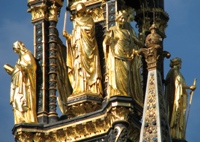
 Redfern's Virtues and Birnie Philip's Angels.
Redfern's Virtues and Birnie Philip's Angels.
Higher still, above four gilt heraldic lions, on the tapering monument, are clustered statues of the eight Virtues, by J. F. Redfern. With some effort amongst all the glinting, we can pick out the accoutrements of at least some of Fortitude, Charity, Justice etc, but I think the point of these figures is to add to the precious, bejewelled effect rather than in much expectation that the viewer will be able to take them in individually.
And finally, just below the summit cross, above the eight Virtues are two tiers each of four Angels, very typical Victorian angel statues these, with wings and arms outspread. Somehow angels in gold have more of an air of familiarity about them, from tombs in churches, and indeed in London one church steeple, which consists of the set by J. C. F. Rossi on the St Pancras Marylebone Road. The Albert Memorial ones are superior, and the work of J. Birnie Philip. This site includes a page on mostly Victorian and Edwardian Angel statues, with a variety of examples.
 West front of the sculptural frieze, by Birnie Philip.
West front of the sculptural frieze, by Birnie Philip.
Having reached the top, we descend to the ground to consider the sculptural frieze all the way round the bottom, the parnassus of 169 figures sculpted in high relief, which like the Sciences, were split between H. H. Armstead and J. Birnie Philip. The themes of the four sides are the Painters and the Poets & Musicians, by Armstead, and the Sculptors and the Architects, by J. B. Philip. They are all labelled with their names, and the viewer may be interested to see those who were chosen to represent modern times, and how our view looking back would have suggested some rather different names. Considering from the artistic viewpoint, there is much in the way the long lines of mainly standing middle aged male figures are grouped to give great interest and life to the frieze - seeing these groups, the viewer cannot but imagine what they would have talked about could they have met. There is something of a touch of humour also in the way some figures are presented as of greater importance than the rest; for example among the sculptors, Michaelangelo, in front of his Medici tomb, has a plinth to sit upon and for others to pay homage to him, and Cellini, with his Perseus beheading Medusa, declaims to a group of respectful sculptors and Palissy the potter; and among the poets, Pythagoras and Homer are on a low plinth, with Virgil leaning in on the left, Dante seated at Homer's feet, and Shakespeare and Chaucer edging in on the right.
There is too much choice in the assemblage to pick out favourites. I will content myself by drawing attention to the group of Greek architects running from Callimachus to Theodorus, and the corner from ancient architects - Nitocris and Cheops to the earliest sculptors starting with a noble unnamed Egyptian and Assyrian and thence to Phidias with a little Parthenon frieze suggested behind, and holding a model of his Athena. And the corner group of sculptors, where Canova converses with Thorwaldsen and David of Angiers while Flaxman, seated, sketches concentratedly. And the group of rather self-preoccupied composers from Handel to Beethoven.
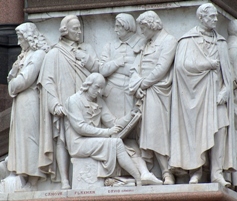
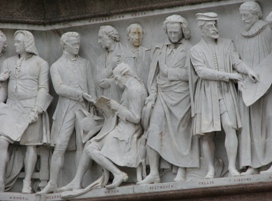 Examples from Birnie Philip's sculptors and Armstead's musicians.
Examples from Birnie Philip's sculptors and Armstead's musicians.
To mention something of the materials, the pillars supporting the canopy are of red granite from the Ross of Mull, and from a grey granite from Castle Wellan Quarries, Northern Ireland. Contemporary newspapers inform us that these latter pillars, of which there are four, were made from single stones, weighing about 17 tons each. Each pillar took eight men about 20 weeks to finish and polish, and the Albert Memorial was noted at the time of its completion as being one of the most costly works in granite of the period. Darley Dale stone was used for the capitals, and the arches are of Portland stone. Pink granite from Correnac, Aberdeen, appears with marble in the pedestal on which the statue of Albert sits.
An interesting comparison may be made of the Albert Memorial with the Victoria Memorial.
We are twice lucky to have the Albert Memorial in its current form at all. Firstly, it could have been something else entirely - there were a variety of ideas for the national monument to Albert, including using Cleopatra's Needle, on the Embankment, or even to have a simple monolith - The Times pointed to the expense, noting that a suitably big one would cost half as much as an iron-plated frigate. That idea was sneeringly dismissed as ‘England may show she can do in the 19th Century what the Ancient Egyptians, and even the painted Britons, were able to accomplish in the Sphinx and Stonehenge.’ Secondly, the Albert Memorial suffered from the general discomfort with all things Victorian during later periods, and due to time, pollution and weather suffered structural damage. For a while at the beginning of the 1990s it was under scaffolding, and due to the cost of conservation, for a while destruction was genuinely put forward as the most reasonable solution. Fortunately, the forces of Barbarism suffered a setback, and the Memorial was conserved. The cost was £10 million, excellently spent, and a visit to see it is a must for anyone interested in art visiting this part of London, and in particular to those of us wishing to see High Victorian statues by some of the most prominent sculptors of the day.
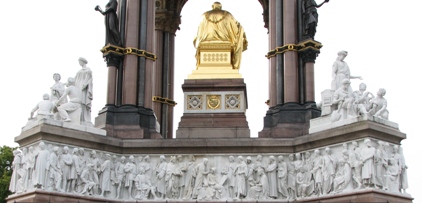 A last view of the Albert Memorial.
A last view of the Albert Memorial.
Albert Memorial in the snow // Albert Memorial mosaics
Sculpture in London // Eastwards to Hyde Park Corner // South past the Albert Hall to the Great Exhibition Memorial
Victoria Memorial by Buckingham Palace // Manchester's Albert Memorial
Visits to this page from 13 Mar 2014: 35,579